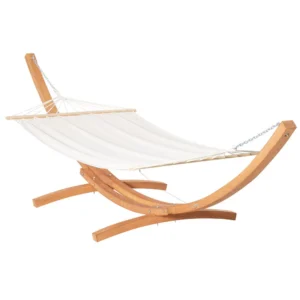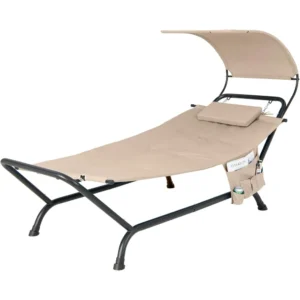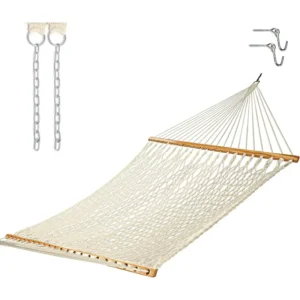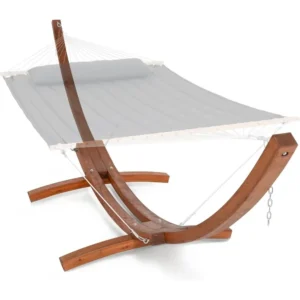The Importance of Understanding Hammock Load Capacity
When you purchase a hammock, one critical specification often gets overlooked: the load capacity. This number indicates the maximum weight a hammock can safely support without risking damage or failure. Understanding this specification isn’t just about preventing your hammock from breaking—it’s fundamentally about your safety.
Proper weight distribution significantly affects your hammock’s lifespan. When used within recommended limits, most quality hammocks can last for years, even with regular use. However, consistently exceeding these limits can lead to premature wear, stretching of materials, and potentially dangerous failures.
It’s important to understand that hammock weight ratings involve two key concepts:
- Static weight – the load capacity when you’re lying still
- Dynamic weight – the capacity when movement occurs (getting in/out, swinging)
Most hammock-related accidents occur because users either didn’t know their hammock’s weight capacity or chose to ignore it. According to safety research, falls resulting from hammock failures are among the most common outdoor furniture accidents, often leading to injuries that could have been prevented with proper attention to weight limits.
Understanding hammock weight capacity guidelines helps ensure a safe and enjoyable experience whether you’re camping in the backcountry or relaxing in your backyard.
What Hammock Weight Limit Numbers Actually Mean
When a manufacturer states that a hammock has a 400-pound capacity, what does this really mean for you as a user? Let’s break down these numbers to understand what’s behind those weight ratings.
Static vs. Dynamic Load Capacity
Static load capacity refers to the maximum weight a hammock can support when you’re lying still. This is typically what manufacturers list as the official weight limit.
Dynamic load capacity accounts for the additional stress placed on a hammock during movement—entering, exiting, adjusting your position, or swinging. This number is often significantly lower than the static rating but rarely specified on packaging.
Safety Margins and Testing
Most reputable hammock manufacturers build a safety margin of 20-25% into their stated weight limits. For example, a hammock rated for 400 pounds may have been tested to hold up to 500 pounds under ideal conditions. However, this buffer isn’t meant to be used regularly—it exists as a safety precaution.
When testing hammocks, manufacturers typically measure:
* The breaking point of materials
* Stress on suspension points
* Durability under repeated loading
Weight Distribution Factors
Weight capacity always assumes evenly distributed weight across the hammock’s surface. Concentrated weight in one area (like sitting rather than lying) puts more stress on specific points and effectively reduces the functional capacity.
| Hammock Type | Stated Capacity | Recommended Usage Limit | Ideal User Configuration |
|---|---|---|---|
| Standard Single | 300-400 lbs | 250-325 lbs | 1 adult |
| Double/Two-Person | 400-500 lbs | 325-400 lbs | 1-2 adults or adult with child |
| Heavy-Duty | 500+ lbs | 400-450 lbs | 1-2 adults or family use |
| Ultralight/Backpacking | 250-350 lbs | 200-300 lbs | 1 adult with minimal gear |
Understanding how weight support works in hammocks can help you make better decisions about which hammock will best meet your needs while maintaining safety.
Critical Factors That Determine a Hammock’s Weight Limit
The maximum weight a hammock can safely support isn’t arbitrary—it’s determined by several key elements working together as a system. Understanding these factors helps you make informed decisions when purchasing and using a hammock.
- Material strength and quality – The fabric or rope used significantly impacts capacity
- Construction techniques – How the hammock is assembled affects its overall strength
- Suspension system – Often the actual limiting factor in total weight capacity
- Weight distribution – Even weight distribution maximizes capacity
- Anchor point strength – The trees, posts, or stands used must support the total weight
Each of these elements has its own weight rating, and like any chain, your hammock system is only as strong as its weakest link. A hammock made of heavy-duty fabric won’t matter if it’s hung with lightweight carabiners that can’t handle the same load.
Let’s examine each factor in detail to understand how they contribute to your hammock’s overall weight capacity.
A. How Material Quality Affects Load-Bearing Capacity
The material of your hammock forms the foundation of its weight capacity. Different materials offer varying combinations of strength, durability, and comfort.
Nylon (parachute nylon) is widely used in camping hammocks due to its exceptional strength-to-weight ratio. Quality parachute nylon hammocks can support 300-500 pounds while weighing mere ounces, making them ideal for backpacking. The higher the denier (thickness) of the nylon, the stronger it typically is.
Polyester offers excellent UV resistance and minimal stretch compared to nylon. This means it maintains its shape and strength better over time when exposed to sunlight, making it ideal for permanent outdoor setups. Polyester typically offers similar weight capacities to nylon but with better long-term performance outdoors.
Cotton provides superior comfort but generally offers less strength than synthetic materials. Traditional cotton hammocks typically support 200-300 pounds, though this varies widely based on weave density and construction quality.
Rope/net hammocks depend entirely on the quality, thickness, and density of the ropes used. Natural fiber ropes generally support less weight than synthetic options like polyester or nylon cord.
| Material | Typical Weight Capacity | Key Strengths | Best For |
|---|---|---|---|
| Nylon | 300-500 lbs | Lightweight, strong, quick-drying | Camping, backpacking |
| Polyester | 300-450 lbs | UV-resistant, minimal stretch | Permanent outdoor installation |
| Cotton | 200-350 lbs | Comfort, breathability | Casual backyard use |
| Rope/Net | 250-450 lbs | Air circulation, varies by material | Warm climates, beach use |
For users requiring additional support, exploring heavy-duty hammock sets specifically engineered with stronger materials can provide greater peace of mind.
B. Construction Quality: The Hidden Factor in Weight Capacity
Beyond the raw materials, how a hammock is constructed dramatically affects its ability to support weight safely. Quality construction techniques distribute force evenly across the hammock and reinforce critical stress points.
Key construction features to look for include:
- Double or triple stitching at all major stress points, particularly where the hammock body connects to end loops
- End-channel designs that distribute weight across the full width rather than concentrating it on a few connection points
- Reinforcement patches at high-stress areas, often visible as extra layers of fabric
- Ripstop patterns in nylon and polyester hammocks that prevent small tears from expanding
The way seams are constructed particularly impacts strength. Look for flat-felled seams (where fabric is folded over itself before stitching) rather than simple overlocked edges in fabric hammocks. For rope hammocks, knot quality and tight, consistent weaving patterns indicate better construction.
Quality control during manufacturing also plays a crucial role. Reputable manufacturers test samples from each production batch to ensure consistent strength and durability, while budget producers may skip this step, resulting in inconsistent quality.
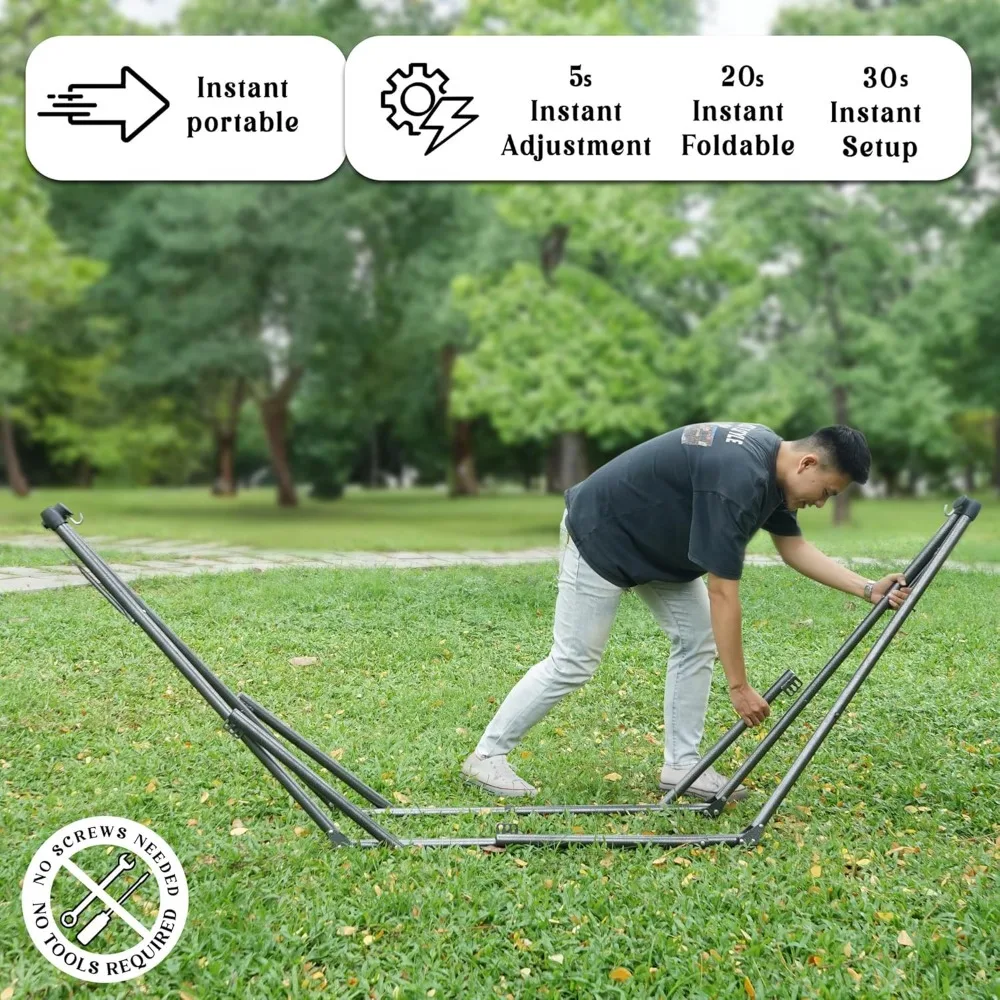
C. Suspension Systems: The Weakest Link Determines Overall Strength
Even the strongest hammock fabric is meaningless if the suspension system fails. In fact, most hammock failures occur not in the bed itself but in the components used to hang it.
Your suspension system includes:
Straps/Ropes: Width and material significantly impact strength. Thin ropes concentrate force and can damage trees, while wide polyester straps (at least 0.75-1 inch wide) distribute weight better and protect tree bark. Look for straps with their own weight rating of at least 400 pounds per strap.
Carabiners/Hardware: Always check the weight rating on carabiners—climbing-grade carabiners typically support 4,000+ pounds, while decorative or lightweight versions might only handle 200-300 pounds. Solid metal S-hooks and rings outperform spring clips for long-term reliability.
Connection Points: How the hammock attaches to the suspension matters. Gathered ends with multiple connection points distribute force better than single-point connections.
For safety, each component in your suspension system should be rated for at least your body weight plus 50%. This provides a necessary margin of safety for dynamic movement.
Our double two-person hammock sets come with appropriately rated suspension systems designed to match the hammock’s capacity, ensuring all components work together safely.
Weight Capacity by Hammock Type: What to Expect
Different styles of hammocks are designed with varying weight capacities to accommodate different users and purposes. Understanding the typical capacities for each type helps you select the right hammock for your needs.
| Hammock Type | Typical Weight Capacity | Best For | Key Considerations |
|---|---|---|---|
| Single Person | 250-400 lbs (113-181 kg) | Solo relaxation, camping | Lightweight, portable |
| Double/Two-Person | 400-500 lbs (181-227 kg) | Couples, parent with child | Wider design, stronger materials |
| Heavy-Duty | 500+ lbs (227+ kg) | Larger individuals, families | Reinforced construction, premium materials |
| Camping Hammocks | 250-400 lbs (113-181 kg) | Backpackers, hikers | Balance between strength and weight |
| Ultralight | 250-300 lbs (113-136 kg) | Minimalist backpackers | Focus on weight reduction |
| Hammock Chairs | 250-330 lbs (113-150 kg) | Sitting position only | Different weight distribution pattern |
Single person hammocks typically provide enough capacity for most adults plus some light gear. These hammocks prioritize a balance between strength and portability.
Double hammocks offer increased width and higher weight ratings, making them suitable for couples or parents with children. Despite the name “double,” most experienced users find them most comfortable with one adult and potentially a small child rather than two full-sized adults.
Heavy-duty options incorporate reinforced stitching, thicker materials, and stronger suspension systems to accommodate larger individuals or multiple users safely.
Camping hammocks vary widely, with ultralight models sacrificing some capacity to minimize packed weight and size. Standard camping hammocks usually offer a good balance of weight capacity and portability.
Understanding the differences between single and double hammock weight limits can help you choose the most appropriate option for your specific needs.
Finding and Verifying Your Hammock’s True Weight Limit
Locating accurate weight capacity information is essential for safe hammock use, but this information isn’t always prominently displayed. Here’s how to find and verify this crucial specification:
Where to look for capacity information:
* Product tags attached to the hammock
* Printed information on packaging
* Manufacturer’s website product specifications
* User manuals or included documentation
If you can’t find explicit weight capacity information, be cautious. Reputable hammock manufacturers always provide this specification. Missing weight information could be a red flag indicating a low-quality product.
Be skeptical of unusually high capacity claims, especially on budget hammocks. If a $20 hammock claims to hold 1,000 pounds, this likely indicates exaggerated marketing rather than actual tested capacity.
When in doubt, contact the manufacturer directly. Most quality hammock companies have customer service representatives who can provide verified weight capacity information for specific models.
For more detailed information about typical capacities across different designs, our guide on how much weight a hammock can hold provides comprehensive reference data.
Understanding the Risks: What Happens When You Exceed Capacity
Exceeding your hammock’s weight capacity isn’t just about breaking rules—it creates genuine safety risks that can lead to equipment failure and personal injury.
When a hammock is loaded beyond its design limits, several things may happen:
Immediate catastrophic failure: The hammock material or suspension components may suddenly tear or break, resulting in falls that can cause injuries ranging from minor scrapes to serious impact trauma.
Progressive material weakening: Even if the hammock doesn’t fail immediately, exceeding the weight limit repeatedly creates microscopic damage to fibers that accumulates over time, making future failures more likely and unpredictable.
Suspension system damage: Overloading puts excessive stress on carabiners, hooks, ropes or straps, potentially deforming metal components or weakening textile elements.
Anchor point damage: Trees, posts, or stands supporting an overloaded hammock can sustain damage. Tree bark can be damaged by excessive pressure, and hammock stands may bend or become unstable.
Most concerning is that failure rarely gives warning. Unlike some equipment that shows visible signs of stress before breaking, hammock failures often occur suddenly, giving users no time to react or protect themselves from falls.
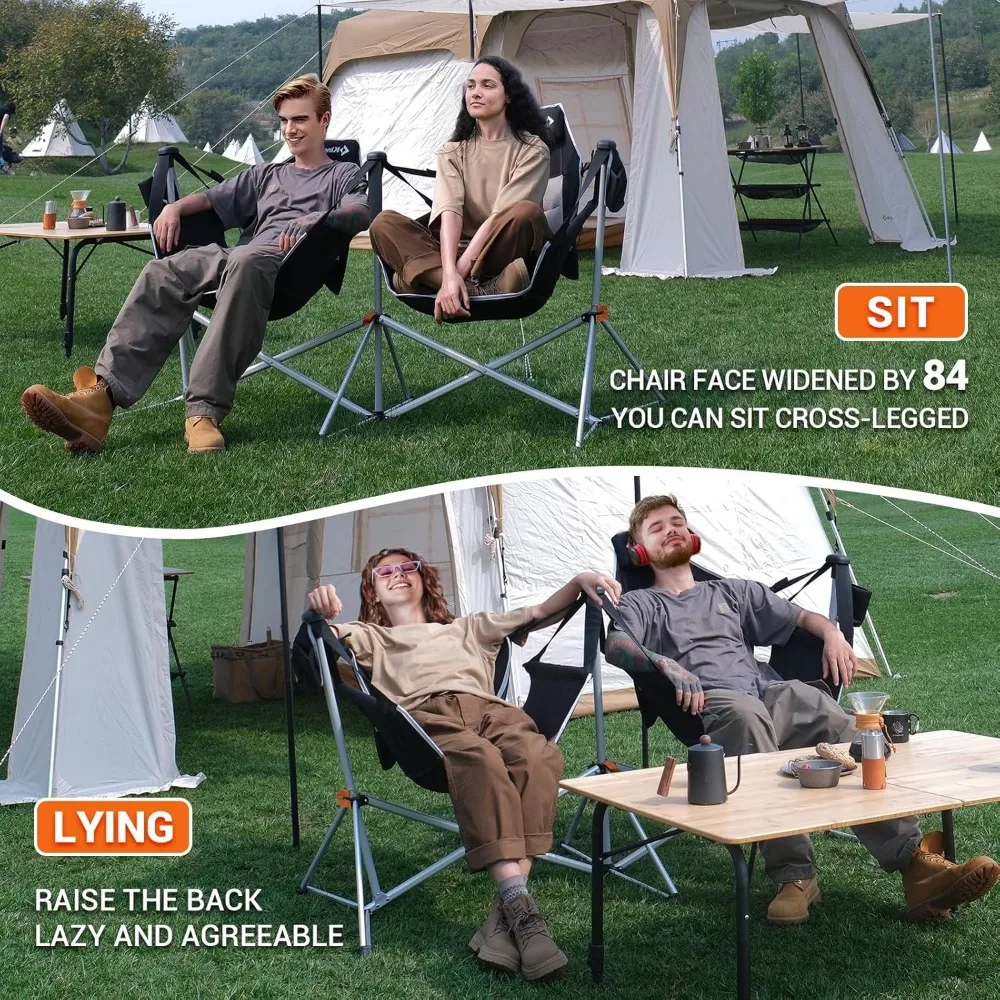
Safety Best Practices for Staying Within Load Limits
Following these safety practices ensures you enjoy your hammock while minimizing risk:
Calculate total weight accurately: Include your body weight plus any gear, pets, or other items that will be in the hammock with you. For shared hammocks, account for all users’ combined weight.
Hang your hammock at the proper angle: A 30-degree angle from horizontal creates optimal weight distribution. Too flat increases lateral force on suspension points; too steep concentrates weight in the center.
Distribute weight evenly: Position yourself in the center of the hammock, lying at a slight diagonal for both comfort and proper weight distribution.
Enter and exit carefully: Lower yourself into the center gradually rather than plopping down. When exiting, shift weight slowly to avoid sudden dynamic loads on one end.
Inspect regularly: Before each use, check for fraying, tears, stretched stitching, or deformed hardware. Pay special attention to connection points where the hammock meets suspension components.
Replace damaged components immediately: Never use a hammock with visible damage or compromised parts, even if the damage seems minor.
Follow manufacturer guidelines: Adhere to all capacity guidelines and hanging instructions specific to your hammock model.
Our camping hammocks and stands are designed with proper weight support in mind, incorporating features that make achieving correct setup easier while maintaining appropriate capacity limits.
Choosing the Right Hammock Based on Weight Requirements
Selecting a hammock that safely accommodates your weight needs requires thoughtful consideration of several factors:
Always choose a hammock with capacity well above your actual weight—experts recommend at least a 20-30% safety margin. This extra capacity accounts for dynamic movement and provides a buffer for safety.
For different user scenarios:
Single adult users: Select a hammock rated at least 50-75 pounds above your weight. If you weigh 175 pounds, look for a minimum capacity of 225-250 pounds.
Couples or parent with child: Choose a double hammock with a minimum 450-pound capacity. Remember that comfort decreases significantly with two adults, even if the weight capacity is sufficient.
Larger individuals: Look specifically for heavy-duty hammocks with reinforced construction and capacities of 400+ pounds. Pay special attention to the width as well as weight capacity for comfort.
Users with pets: Add approximately 30-50 pounds to your weight requirements if you plan to regularly share your hammock with medium-sized dogs or multiple small pets.
When selecting your ideal hammock, consider that ultralight models often sacrifice some capacity for weight savings. If you’re close to the weight limit, consider moving up to the next capacity level.
A-Frame Stand Hammock Sets, Swinging Hammock Chair Sets
$154.62 Select options This product has multiple variants. The options may be chosen on the product pageCamping Hammock Sets with Bug Net, Ultralight Camping Hammock Sets
$139.72 Select options This product has multiple variants. The options may be chosen on the product pageClassic Wooden Stand Hammock Sets, Heavy Duty Hammock Sets
$1,061.68 Select options This product has multiple variants. The options may be chosen on the product pageHammock Sets with Canopy, Heavy Duty Hammock Sets
$286.31 Select options This product has multiple variants. The options may be chosen on the product pageDouble / Two Person Hammock Sets, Rope Hammock Sets
Double Traditional Cotton Rope Hammock with Extension Chains – 450 lbs Capacity for Backyard & Patio$292.98 Select options This product has multiple variants. The options may be chosen on the product pageHeavy Duty Hammock Sets, Wooden Arc Stand Hammock Sets
$878.66 Select options This product has multiple variants. The options may be chosen on the product page
For those requiring specialized options, our guide to hammocks for heavier individuals provides detailed recommendations tailored to your needs. Additionally, if weight is a primary concern for backpacking, our ultralight camping hammock sets offer appropriate weight limits while minimizing pack weight.
Common Questions About Hammock Weight Capacity
Do spreader bars increase or decrease weight capacity?
Spreader bars typically decrease overall weight capacity because they create fixed stress points and change how weight is distributed across the hammock. However, they do make entry and exit easier and provide a flatter lying surface.
How does dynamic movement affect the practical weight limit?
Dynamic movements like swinging, bouncing, or rapid entry can temporarily double or triple the effective forces on your hammock. This is why staying at least 20% under the static weight limit is recommended for active users.
Can I trust an unmarked hammock’s capacity?
No. If a hammock doesn’t specify its weight capacity, consider it a serious red flag. Quality manufacturers always test and clearly state weight limits.
What’s more important: the hammock or suspension capacity?
Both are equally critical. Your hammock system is only as strong as its weakest component. Always ensure suspension components (straps, carabiners, etc.) are rated for at least the same capacity as the hammock itself.
How much does capacity decline with age and use?
With proper care, most hammocks maintain their rated capacity for years. However, exposure to UV light, moisture, and frequent loading near maximum capacity can reduce strength by 10-20% annually. Inspect regularly for signs of wear.
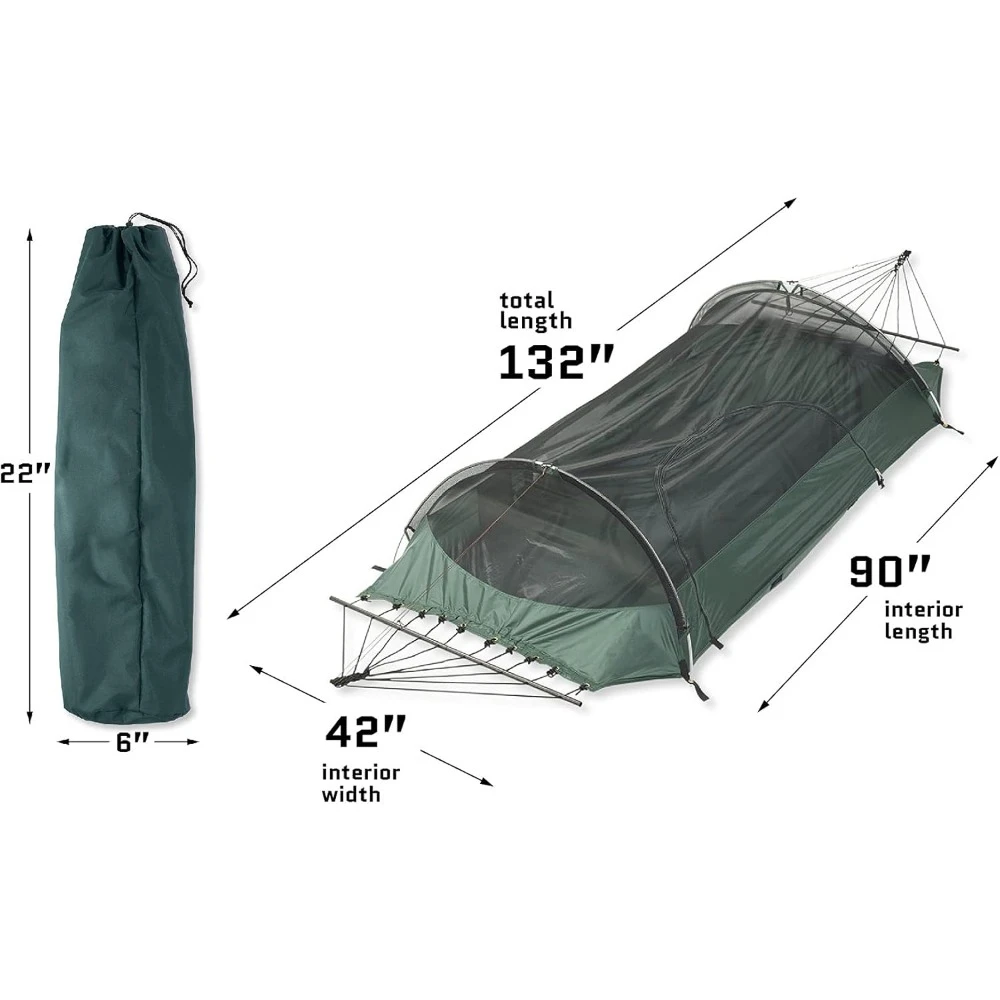
Expert Tips for Extending Your Hammock’s Weight-Bearing Lifespan
• Clean according to material type: Remove dirt, salt, and oils that can break down fibers. Synthetic hammocks can typically be machine-washed on gentle cycle; cotton and rope hammocks often require hand washing.
• Protect from UV damage: Store indoors or under cover when not in use. UV radiation is particularly damaging to nylon hammocks, reducing strength over time.
• Dry completely before storage: Prevent mold and mildew that weaken fibers. Never store a damp hammock.
• Redistribute weight regularly: Change your typical lying position occasionally to prevent one area from receiving all wear.
• Consider hammock liners: These protect the main hammock body from oils, dirt and friction while being easier to clean.
• Replace suspension components proactively: Straps, ropes and carabiners should be replaced at first signs of wear, even if the hammock body remains in good condition.
• Use tree-friendly straps: Wider straps (>1 inch) protect both trees and your equipment by distributing pressure more evenly.
Understanding safe hammock weight limits by design helps you make better maintenance decisions to extend the life of your hammock while maintaining safety.
Is Your Hammock Stand Rated for the Same Capacity?
Many hammock users overlook a crucial element of their setup: ensuring the hammock stand can safely support the same weight as the hammock itself. A mismatch here creates a dangerous weak point in your relaxation system.
Most metal hammock stands are rated for 250-450 pounds, depending on design and materials. Wooden stands typically support 250-400 pounds but vary significantly based on construction quality. Portable stands generally have lower weight capacities (200-300 pounds) due to their lightweight design priorities.
Signs that a stand might be approaching its weight limit include:
* Creaking or unusual noises during use
* Visible bending or flexing of support bars
* Unstable movement when entering or exiting
* Loose connections between components
If your stand doesn’t clearly state its weight capacity, contact the manufacturer directly. Never assume a stand can support the same weight as your hammock without verification.
Our A-frame stand hammock sets are engineered with carefully matched capacities, ensuring both components work together safely as an integrated system.
Conclusion: Balancing Enjoyment and Safety
Understanding hammock load capacity is fundamental to both safety and enjoyment. By selecting a hammock with appropriate weight capacity for your needs, checking all components of your suspension system, and following proper setup procedures, you create the foundation for worry-free relaxation.
Remember that the best hammock isn’t necessarily the one with the highest absolute weight rating—it’s the one that balances your specific needs for capacity, comfort, durability, and intended use. Quality materials and construction make a significant difference in both safety and longevity.
Regular inspection and maintenance help ensure your hammock maintains its load-bearing capabilities over time. When in doubt, err on the side of caution by choosing higher capacity ratings than you think you’ll need.
With proper attention to weight capacity and safety practices, your hammock can provide years of comfortable, safe enjoyment in any setting.




